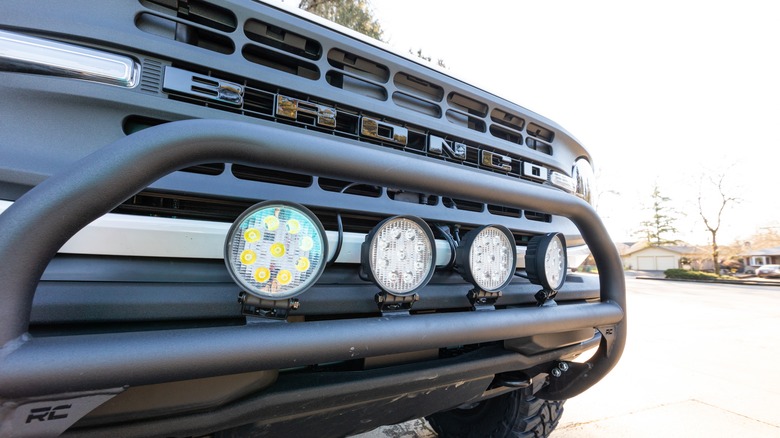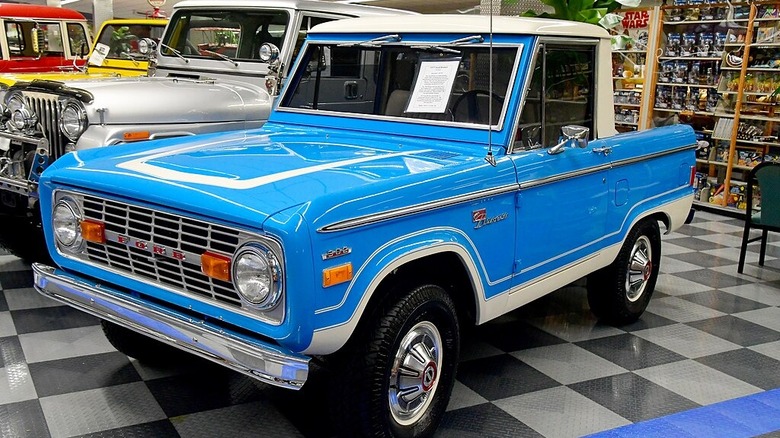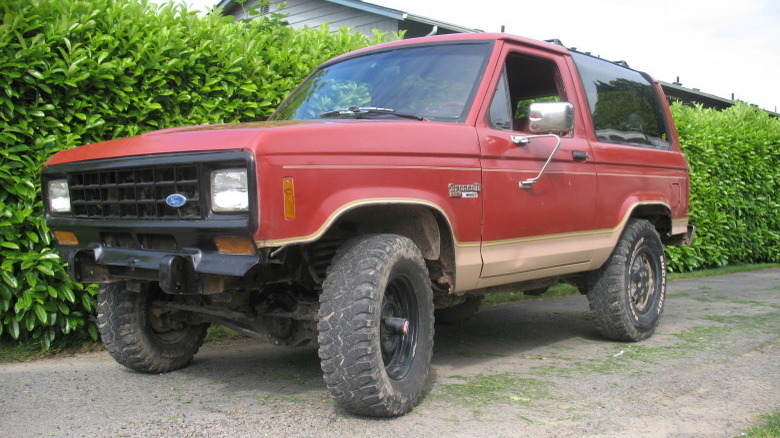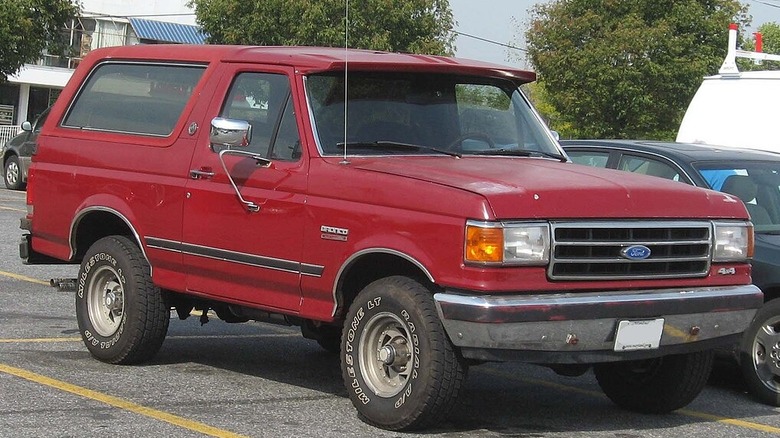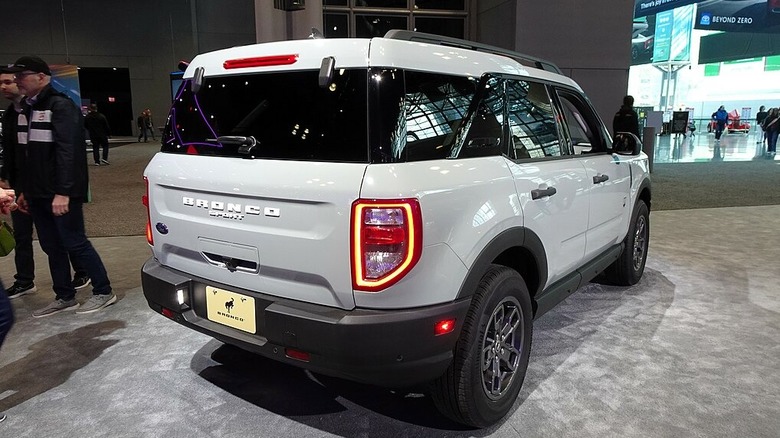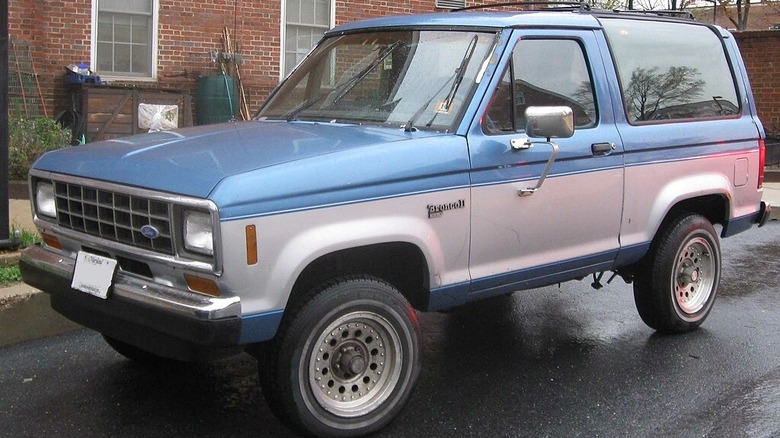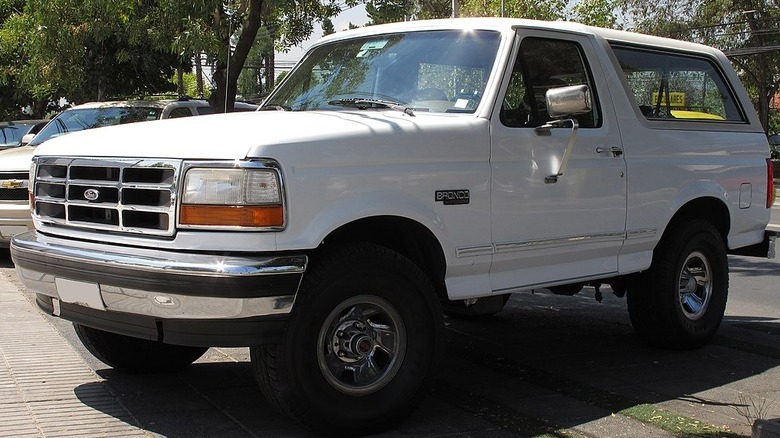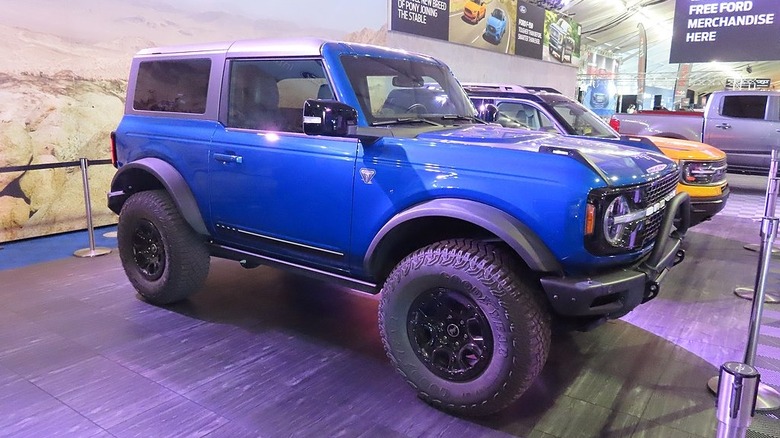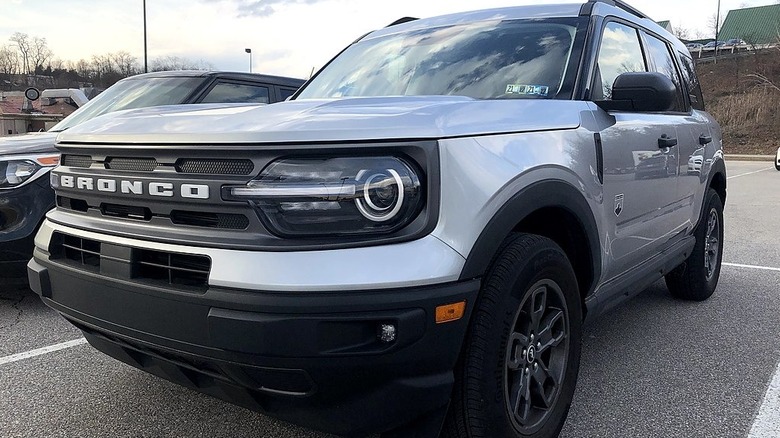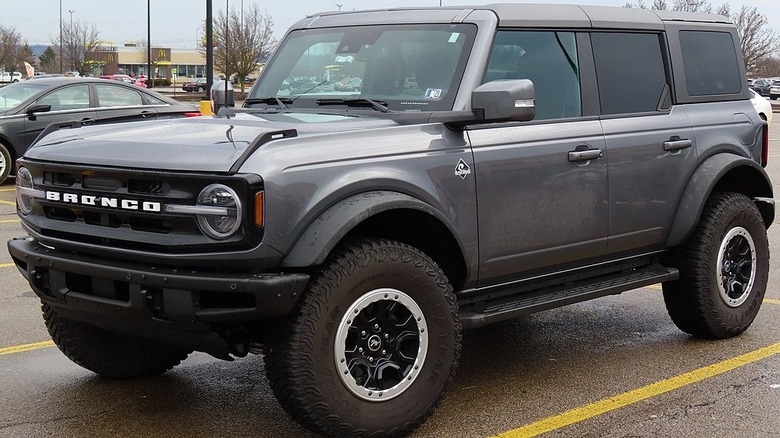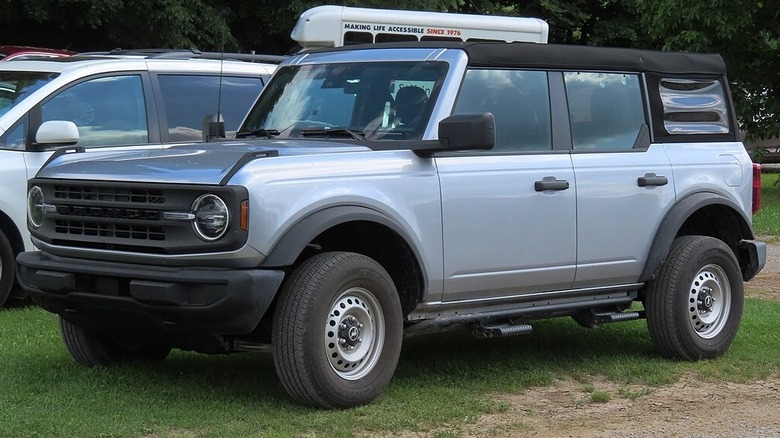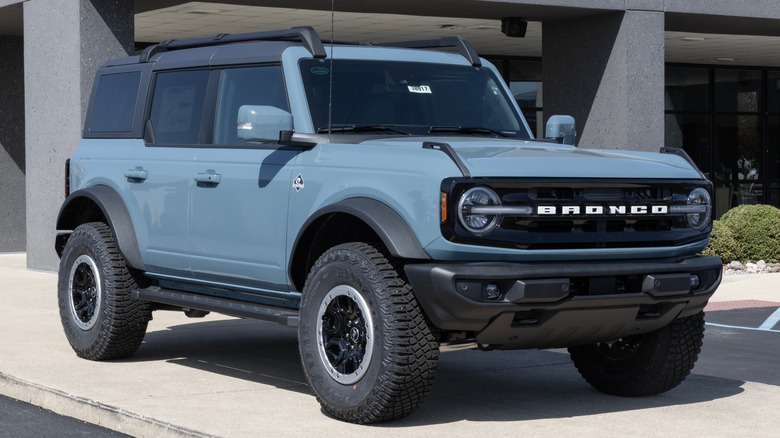The Best Years For Ford Bronco (And Some To Avoid)
The Ford Bronco was one of many iconic trucks that paved the way for modern SUVs, and countless old-school models are still on the road today. Not only that, but Ford has revived the Bronco with plenty of nostalgic — though apparently, not always with peak performance too.
With all the new features and improvements, new Broncos look appealing, and there's no shortage of new technology under the hood and in the driver's seat. Yet many of the newer Ford Broncos have some of the worst reviews. Given that fact, the classics could still be a better buying option, even decades after release. But not every year is an absolute winner, according to driver-supplied data, recalls, and other information, so there are some good and bad options throughout the Ford Bronco's lifespan.
As a non-Ford enthusiast who happened to drive a Ford Bronco for a few of my high school years, I have a personal bias for a specific year of Bronco, but there's more to the story than my Ford's broken speedometer and uncomfortable driver's seat.
Here are the best Ford Bronco years and some to avoid, based on data reported to the National Highway Traffic Safety Administration (NHTSA), industry (and consumer) reputation, and availability. Details on our methodology will follow the list of years to avoid.
Best: 1977 Ford Bronco
Ford first released the Bronco all the way back in the 1960s in response to other off-road SUV models. As a contemporary of vehicles like Jeep's CJ-5, Toyota's Land Cruiser, and International's Scout, the original Bronco had similar styling to the rest of its competitors. Ford didn't enjoy quite as strong a reputation as Jeep, at least when it came to the 4x4 experience, but the original style caught on, and spawned multiple generations.
In 1977, the final year of the first generation of Bronco, Ford outdid itself with the version, even though only a few improvements were made. It made sense for the 1977 to be near-perfect, as by that time, the competition also included the Chevrolet Blazer and Chrysler Ramcharger and Trail Duster. Improvements over the years culminated in a Bronco that went out with a bang in 1977, featuring gas tank doors (versus exterior caps), a heavy-duty rear end housing, and modified rear marker lights. Notably, this also was the last smaller-sized Bronco before a larger model rolled out in 1978.
A Gen 1 Ford Bronco might be the best one to buy, but it could cost you. Sought-after "classic" Broncos, which had very few NHTSA issues and only two recalls (one in 1976 and one in 2007), go for tens of thousands — if not hundreds of thousands — of dollars.
[Featured image by Eric Friedebach via Wikimedia Commons | Cropped and scaled | CC BY 2.0]
Best: 1983 Ford Bronco II
In 1980, Ford released the third generation of Ford Bronco, know as the Bronco II. The compact SUV had similar styling to the first-generation Bronco, but the smaller model seemed to be a hit. The third-gen Broncos, from 1980 to 1986, had the highest production numbers with 322,429 vehicles produced between those years.
Fortunately for enthusiasts, the high production numbers could mean it's easier to find a 1983 model Bronco for sale. The price might be right, too; used 1983 Broncos seem to start at around $7,000, though they can range into the tens of thousands of dollars depending on the condition.
Apart from availability and price, a 1983 Ford Bronco is also one of the best years in terms of NHTSA issues. There are no documented recalls on the 1983 Ford Bronco II on the NHTSA website, and only one investigation was noted. Said investigation — which took place in 1997 — was spurred after a complaint regarding "handling and stability defects."
With no follow-up information on the investigation, we can't assume anything about the results, but the lack of consumer complaints and recalls seems to suggest the 1983 Bronco II is a good buy.
Best: 1987 Ford Bronco
Fourth-generation Ford Broncos (1987-1991) might be some of the easiest to find today, mostly because they're not exactly vintage yet. Any 30-plus-year-old car will have some problems, a while it's not edging into obsolete territory, it's technically a classic.
I drove one of these in high school for a while, and it had its fair share of problems, including a speedometer issue that had me guessing at highway speeds and some other dashboard failures that resulted in chewing gum and paper clip type fixes. The gas mileage was also poor, but that's a given with a V8 of any era.
Despite that, my Bronco stayed on the road well into the 2010s, with plenty of get-up-and-go when I needed it as a heavy-footed teen driving winding roads. When my family sold the Bronco to someone who was very eager to take it off our hands, I was shocked anyone wanted it. These days, the sticker price on a 1987 Ford Bronco seems to start at around $3,000, but many sales listings are much higher.
Another point for the 1987 Bronco? There are surprisingly few recalls or customer complaints to the NHTSA, with fewer than 50 over the last 35 years and only one 1987 recall on the fuel lines (which we assume has been repaired by now).
Best: 2024 Ford Bronco
If you have your heart set on a brand-new Ford Bronco, there's some bad news. Most of the revived Ford Broncos have their fair share of issues, and thus, the new model we would cautiously call the "best" is the only-once-recalled (so far) 2024 Bronco.
Of all the new Ford Broncos post-2021, 2024 might be the best bet, but take this advice with a grain of salt. To date, it has few consumer complaints and recalls, per NHTSA data, with two recalls early in 2024. Possible child safety lock issues affected just under 10,000 Broncos (with a free dealer fix), and a rear glass panel problem impacted just under 8,000 (also a free dealer-supported fix).
To date, the NHTSA doesn't have many documented complaints against the 2024 Ford Bronco, but of course, there's plenty of time for them to roll in. The few complaints so far don't appear to share a common theme, which suggests the Bronco — like any other vehicle — sometimes has one-off issues.
Quality concerns aside, the 2024 Bronco has a variety of trim options and could be appealing to enthusiasts who want upgraded but still classic styling in a warrantable (read: dealership-sold) package. A new 2024 Ford Bronco starts at just over $39,000 for a two-door "mainstream off-roading" Big Bend Bronco. You can also find used 2024 Broncos starting at around $25,000, depending on condition and mileage.
[Featured image by Charles via Wikimedia Commons | Cropped and scaled | CC BY 2.0]
Avoid: Bronco II
Despite early promise in the small SUV market, the Bronco II is widely regarded as a flop due to safety testing issues. Debuting in 1983, the Ford Bronco II was a compact SUV that entered the market while Ford was still producing standard-size models from 1984 through 1990. With the styling of the Ford Ranger, the Bronco II had three doors (counting the back gate as a door) a la the Chevy Blazer and GMC Jimmy.
While it wasn't alone in the compact SUV market, the Bronco II quickly earned the worst reputation for being unsafe. Rumors of Ford's knowledge of rollover issues quickly spread, and the company did in fact nix some driving maneuvers from its testing program because of safety risks to its drivers, despite making no design changes and continuing to push the Bronco II regardless.
In 1989, Consumer Reports joined the fray and advised against buying the Bronco II because of rollover hazards. Later, the Insurance Institute for Highway Safety (IIHS) quoted a rate of 3.7 fatalities per 10,000 Bronco II rear-wheel-drive models and 1.7 for the four-wheel-drive Bronco II.
While the 1983 Bronco II had the fewest reported issues to the NHTSA, proceed with caution with any other model year. 1988 was the worst year for NHTSA complaints, with most related to the electrical system. Notably, only four investigations are in the NHTSA data (two are for rollover issues), and no recalls were issued.
Avoid: 1993 Ford Bronco
Some older-model Ford Broncos are still worth buying, but one you should definitely avoid the 1993 edition. The '93 Bronco was the subject of various NHTSA recalls, coming in fewer than only the 2021, 2022, and 2023 editions.
Ford recalled the 1993 Bronco seven times, with two major recalls related to the speed control deactivation switch, which could malfunction and spark an under-hood fire. More than 3.6 million units were impacted, and a separate emergency parking brake recall impacted over 800,000 vehicles. In theory, if you were buying a classic 1993 Bronco today, it would have had the recall-related issues fixed long ago. However, it might not be worth the potential headache for buyers; complaints as late as the 2010s have been reported to the NHTSA, suggesting it hasn't been smooth sailing since the '90s.
Then there's also the fact that the 1993 Ford Bronco is famous for being the car O.J. Simpson drove during his infamous televised police chase, as it's still very much associated with that. Simpson's white Bronco XLT eventually wound up in a museum, but if any others are still on the road today, they might not be highly sought-after for obvious reasons.
A 1993 Ford Bronco appears to go for around $9,000 and up, depending on the condition and mileage, but this model year does appear to be slightly cheaper than the surrounding model years (go figure).
[Featured image by RL GNZLZ via Wikimedia Commons | Cropped and scaled | CC BY-SA 2.0]
Avoid: 2021 Ford Bronco
Ford discontinued the Bronco after 1996, but revived it in 2021. Unfortunately, the sixth-generation Bronco wasn't a complete hit, possibly because it was a mostly new remodel of the old favorite. When the 2021 Bronco was new, it had a starting MSRP of $29,995, but the demand apparently caused issues with production.
An order backlog resulted in some drivers not receiving their production vehicle on time — if at all — which suggested the rollout wasn't well-coordinated by Ford. Further, eight recalls impacted things like the rearview camera, seatbelt functionality, and some airbag sensors. A handful of investigations by Ford explored loss of power and fuel pump failure, the former of which may have been spurred by customer complaints about the same issue.
To date, in addition to the NHTSA recalls, the 2021 Ford Bronco has had over a hundred complaints, with most related to engine problems, namely losing power in dangerous conditions (like on the freeway). Many complaints cited engine failure either resulting in mechanics declaring they needed a new engine or the consumers themselves saying so after multiple episodes of the same problem.
While drivers were clearly excited to buy the brand-new Bronco, for many it turned out to be largely a letdown. The good news is that for now, the 2021 Bronco seems to have retained most of its resale value, with models listed for sale at around $28,000 or higher depending on the specs and mileage.
[Featured image by HJUdall via Wikimedia Commons | Cropped and scaled | CC BY-SA 4.0]
Avoid: 2021 Ford Bronco Sport
2021 was seemingly a bad year for the Bronco all-around, with the Bronco Sport version having nearly as many issues as the base model. Despite a five-star safety rating, the car has over 300 NHTSA complaints. Consumers reported problems with everything from the electrical system (instruments going haywire or becoming unresponsive) to the brakes (squealing and other "abnormal" sounds) to miscellaneous startup problems and other wild noises in various parts of the vehicle.
Fortunately, Ford seemed to fix most of those and other reported problems with an array of recalls; nine recalls covered loss of power (over 450,000 vehicles impacted), crack-susceptible fuel injectors (over 520,000 vehicles affected), and oil leaks (over 340,000 vehicles impacted). Notably, Ford appeared to wait until 2024 to launch an investigation into the power problems in the 2021 Sport model, with an April 2024 recall addressing "loss of drive power from undetected low battery."
In all, this assortment of issues seems to be a warning for prospective buyers to stay away from the Sport edition — and somewhat explains a potential used purchase price as low as $18,000.
In even more bad news, the 2023 Ford Bronco Sport may not be much better, either, given that nostalgia comes at such a high sticker price and the fact that the Sport model has plenty of reported problems. But more on the 2023 Bronco later.
Avoid: 2022 Ford Bronco
A slew of NHTSA recalls impacted the 2022 Bronco. Nine recalls spanned everything from incorrect stickers to over 175,000 vehicles with potential seat belt latch problems, over 63,000 vehicles with windshield breakage concerns, and over 53,000 vehicles potentially impacted by child safety lock malfunctions.
In short, the 2022 Bronco is not a promising purchase used, and the nearly 200 complaints collectively scream "buyer beware." Most consumer complaints were categorized as visibility-related, while the runner-ups were engine, power train, and brake issues, though there were also some concerns about the electrical system.
An assortment of miscellaneous concerns cover every aspect of the 2022 model year, and there were nearly as many manufacturer communications as consumer complaints per the NHTSA. Ford's primary communications related to the electrical system, structure, and power train.
Given all these potential problems, our advice is to avoid the 2022 Bronco, but it seems there's a subset of perfectly satisfied consumers that only have positive things to say. In online forums, some drivers report zero issues with their 2022 Broncos, despite having concerns about reliability before purchase. Notably, the majority of drivers who offered feedback selected the 2.3-liter four-cylinder Bronco, while pointing out that many issues presented in only the 2.7-liter V6.
[Featured image by MercurySable99 via Wikimedia Commons | Cropped and scaled | CC BY-SA 4.0]
Avoid: 2023 Ford Bronco
Despite its high cost, in our review of the 2023 Ford Bronco, we found it mostly hit the mark in off-road performance. Unfortunately, soon after its release, the 2023 model began racking up recalls and consumer complaints. Eight NHTSA recalls and some missing stars on the safety rating (the NHTSA doesn't give an overall safety rating, however) may warn Bronco enthusiasts away, with a variety of problems seemingly culminating in a massive hazard warning from the NHTSA.
An "urgent" warning against driving the 2023 Bronco without recall repairs pops up on the NHTSA's website, specifically related to just over 1,000 Broncos with potentially "improperly tightened wheel lug nuts." Other issues included seat belt latch access problems, potentially detachable (and not intentionally) rear glass panels, and child safety lock malfunctions.
In short, there's a lot to look out for, and despite the recalls and manufacturer fixes, consumers have racked up plenty of complaints about everything from windshield visibility and wipers to the power train, engine, brakes, and more. At a sticker price of over $30,000 for a used 2023 Ford Bronco, this is another one to skip due to the potential safety issues.
[Featured image by MercurySable99 via Wikimedia Commons | Cropped and scaled | CC BY-SA 4.0]
Methodology
There is some confusion in NHTSA records; it lists a 1996 Ford Bronco II separately from a 1996 Ford Bronco two-door, but the Bronco II wasn't manufactured after the 1990 model year. The NHTSA data may be referring to second-generation Broncos (though the second generation began in 1978 and ended in 1979), but the site itself is unclear.
Given these inconsistencies, we didn't rely solely on NHTSA advisories to choose the best or worst Ford Bronco models. Popular culture influenced one pick, and the best years were those with the best reputation in the court of public opinion. Similarly, the ones to avoid are those with poorer track records for safety issues, including recalls, investigations, and news reports of problems.
We considered the models with the highest number of NHTSA recalls, complaints, and investigations to be the ones to avoid, while avoiding the seemingly incorrect listings altogether.
